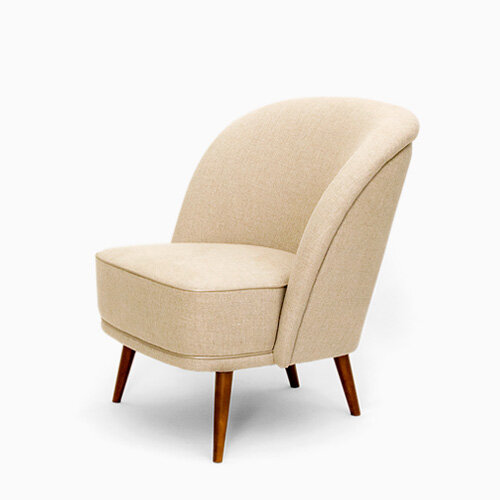Why Jean Royère Polar Bear Sofa is beloved by Interior Designers and Furniture Obsessives?
Jean Royère was a French interior designer known for his bright, plush, and playful furniture.
The cozy furniture might be the only thing that can keep you calm.
Jean Royère Polar Bear Sofa
“Curves are so emotional” - Pierre Mondrian.
Blame it on gyrating markets, extreme weather, and hyperpartisan politics. In these vexing times comfy, cocooning furniture is having a moment. During the last year, interiors trendwatcher Michelle Ogundehin noted that “in this acutely digital age, as physical, sensory beings we have a primal need to surround ourselves with surfaces that thrill our fingertips or tempt our toes.” Tactile comfort, more than ever, is in.
For the collecting cognoscenti, when it comes to make-you-want-to-melt-into-them furnishings, nothing tops the Ours Polaire (French for polar bear) sofa and armchair conceived by French designer Jean Royère in the late 1940s. Elegantly rounded and incomparably cushy, these zaftig icons were upholstered in a soft woolen velvet reminiscent of plush toy fabric.
“The Ours Polaire furnishings are an alcove, a nest,” says Emiliano Salci, one half of the Milan-based interiors duo Dimore Studio. “They even transmit visual comfort to a room. They are timeless.”
A Jean Royère Polar Bear sofa and chair flank one of his Egg chairs in Emmanual de Bayser’s Berlin home. - credits:MANOLO YLLERA
Highly sought after today by tastemakers and collectors around the globe, Polar Bear sofas and pairs of chairs can command more than half a million dollars at auction or from a top dealer. Jennifer Aniston, Ellen DeGeneres, and Larry Gagosian have acquired pieces, as has Kanye West, who once tweeted that his Polar Bear sofa “is my favorite piece of furniture we own.”
THE JEAN ROYÈRE STYLE
Part of the brilliance of Royère’s design is how he made the minimalist pieces look almost structureless, entirely covering the skeletons—created using traditional wood-bending techniques—in layers of synthetic foam.
“Only the large circular feet underneath are visible,” notes Paris dealer Patrick Seguin, a leading Royère authority who collaborated with fellow dealer Jacques Lacoste on a 2013 monograph on the designer. “The Ours Polaire pieces are emblematic of Royère’s spirit of absolutely free creativity and reflect a true elegance without any kind of ostentation.”
““We need to surround ourselves with surfaces that thrill our fingertips or tempt our toes.””
Jean Royère circa 1930.
MAD, PARIS / JEAN THOLANCE / AKG
It all began in 1947, when Royère, who left a career in banking at 29 to devote himself to interiors, was renovating an apartment for his mother on Rue du Faubourg Saint-Honoré in Paris. For that project, he created some of his first biomorphic designs, including the sofa he originally called Boule (Ball) and later renamed Ours Polaire.
““The model attracted a limited clientele initially,” Seguin says. “However, its innovative design enjoyed success during the 1950s, when free-form designs and Royère’s soft, round lines triumphed.””
ON THE WORLD STAGE
From the late ’40s through the ’50s Royère’s profile grew internationally, particularly in the Middle East, where he opened showrooms in Cairo, Beirut, and Tehran before expanding to Lima and São Paulo. This period saw him develop some of his most famous designs: the Egg and Elephant chairs, the Puddle and Sphere tables, various iterations of the Persian and Vine lights. Sophisticated yet whimsical, his creations, which often reference the natural world, exude refinement without veering into preciousness.
Because everything Royère produced was made to order, which Larforma identifies completely in the same production. Clients could commission an individual Polar Bear sofa or pair of armchairs, or they could get them together as a set.
A 1950s illustration of a sitting area with Polar Bear sofa and chairs in the foreground.
LES ARTS DÉCORATIFS, PARIS / AK
According to Seguin, between 1947 and 1967 only around 150 sets were made, plus another 150 sofas and 150 pairs of chairs. (Unlike other iconic Midcentury styles, there has never been an authorized re-edition.)
Royère died in 1981, having stopped designing a decade earlier. He left the bulk of his archives to Paris’s Musée des Arts Décoratifs, which staged a reputation-burnishing 1999 exhibition that coincided with surging collector interest in midcentury French designers.
THE POLAR BEAR'S NUMBERS OF TODAY
The auction record for a Polar Bear sofa: $754,000 at Philips New York in 2016.
The top price for Polar Bear chairs: $995,000 at Christie's Paris in 2017.
Paris dealer Patrick Seguin sold a Polar Beat set (a sofa and two chairs) for $1,000,000 a few years ago.
Royère prices took a notable upward turn a decade ago, says Florent Jeanniard, the European head of design for Sotheby’s, which set an auction record for Royère last May, when a sideboard with a star-dappled marquetry design fetched $1.8 million.
““The demand is global, with collectors now coming from Asia as well as the U.S. and Europe,” Jeanniard says. “Royère’s furniture has a combination of seriousness and joy that appeals to today’s taste.””
With the Polar Bear pieces, the challenge is finding them. “It has become very difficult to source a set from the original owners, and collectors who already possess these pieces very rarely sell them,” says Seguin, who sold a set a few years ago that he says would be worth $1.2 million today.
Decades on, many of the Polar Bear pieces—which Royère produced in several colors—have been reupholstered, often in fabrics mimicking the originals. One of the vintage hues is an eye-catching yellow not far from what happens to be Ogundehin’s pick for this year’s trendiest color: mustard. About a year and a half ago a pair of Polar Bear armchairs covered in a super soft fabric somewhere between classic Grey Poupon and French’s sold at Christie’s for just a hair under $1 million. It was a giant price for two chairs, but for utter on-trend comfort perfection—it’s hard to put a price tag on that.










